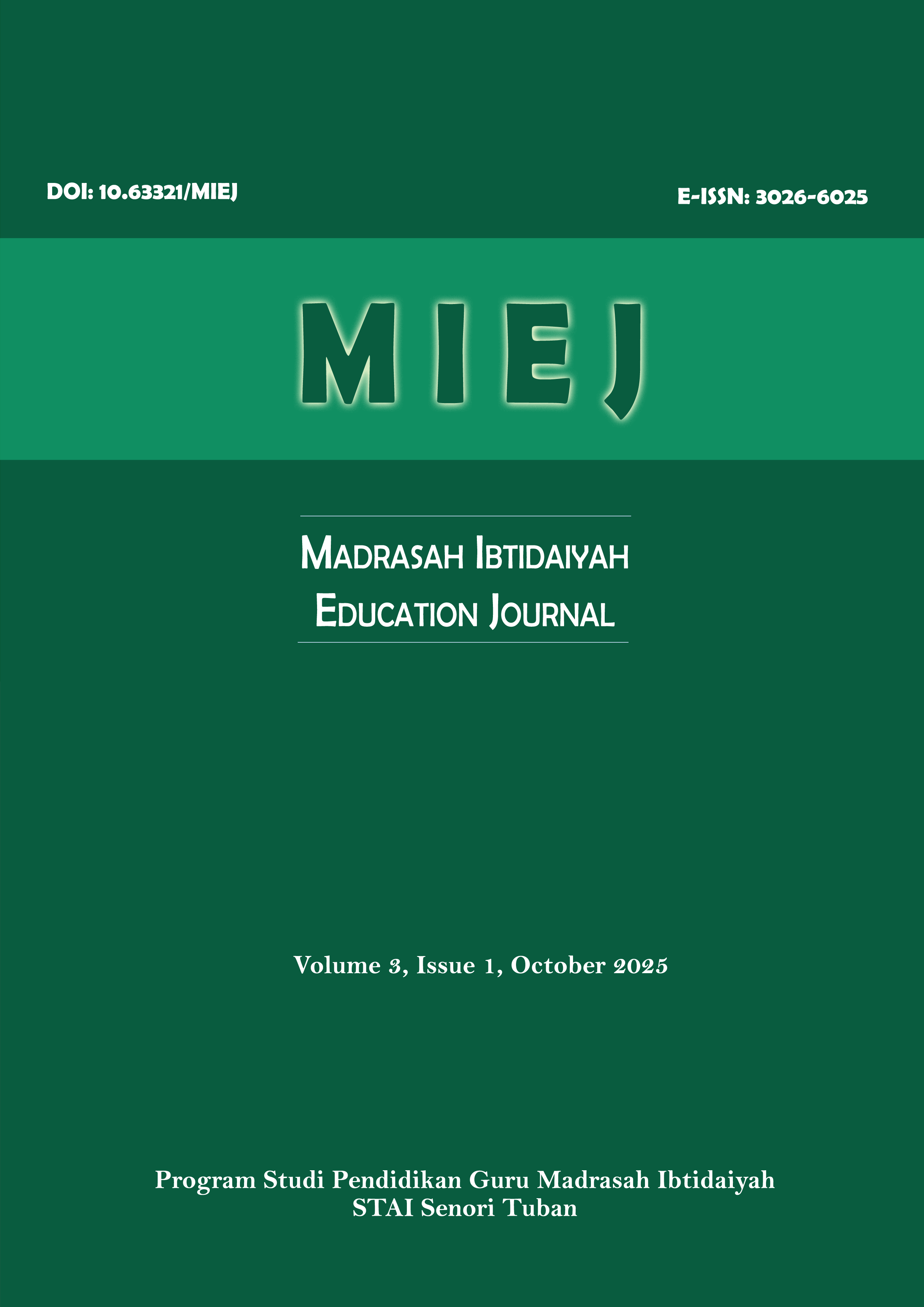Penggunaan Metode Suku Kata dalam Meningkatkan Kemampuan Baca Anak Kelas I di MI Islamiyah Kedungjambe Tahun Pelajaran 2024/2025
DOI:
https://doi.org/10.63321/miej.v3i1.124Keywords:
Syllable method, Reading ability, Elementary school students.Abstract
The lack of reading ability among 1st-grade students at MI Islamiyah Kedungjambe focuses on the use of the syllable method, supporting and inhibiting factors, and the results of using the syllable method in improving the reading ability of 1st-grade students at MI Islamiyah Kedungjambe. This study uses a qualitative approach. The subjects of this research are 19 students of the 1st grade at MI Islamiyah Kedungjambe. The research employs data collection techniques such as interviews, observations, and documentation. The results of this study include the development of syllable methods that positively assist students who have difficulty reading. There are several steps and preparations in using this method, such as the teacher arranging/combining consonant letters and vowel letters, and preparing media in the form of markers and a whiteboard as part of the preparation. There are several supporting and hindering factors in the use of syllable methods; one of them is the interest in reading within the students, and hindering factors from within the students, such as lack of attention. The results of using the syllable method are very helpful, as evidenced by the scores obtained before and after using the syllable method, which increased from 30% to 70% in training students to read well and correctly.
Downloads
References
Ardiansyah, Risnita, & Jailani, M. S. (2023). Teknik Pengumpulan Data Dan Instrumen Penelitian Ilmiah Pendidikan Pada Pendekatan Kualitatif dan Kuantitatif. Jurnal IHSAN : Jurnal Pendidikan Islam, 1(2), 1–9. https://doi.org/10.61104/ihsan.v1i2.57
Arwan, Z. (2019). Pendidikan dan Konselor dalam Kompetensi Pedagogik, Kepribadian, Profesional dan Sosial Perspektif Konseling Pendidikan Islam. In Proceeding International Seminar and Coference Guidance and Counseling (Nomor 1).
Aswat, H., & Nurmaya G, A. L. (2019). Analisis Gerakan Literasi Pojok Baca Kelas Terhadap Eksistensi Dayabaca Anak Di Sekolah Dasar. Jurnal Basicedu, 4(1), 70–78. https://doi.org/10.31004/basicedu.v4i1.302
Dalegi, F. R., Mingkid, E., & Rondonuwu, S. (2019). Persepsi Masyarakat Tentang Berita Online Di Surat Kabar Sindo. Acta Diurna Komunikasi, 1, 12. https://ejournal.unsrat.ac.id/index.php/actadiurnakomunikasi/article/view/26314/0
Fadli, Z., Sirajuddin, N. T., & Wahditiya, A. A. (2024). English Corner: Training Reading and Writing Skills. Jurnal Pustaka Mitra (Pusat Akses Kajian Mengabdi Terhadap Masyarakat), 4(2), 55–66. https://doi.org/10.55382/jurnalpustakamitra.v4i2.701
Febriani, E. S., Arobiah, D., Apriyani, Ramdhani, E., & Millah, A. S. (2023). Analisis Data dalam Penelitian Tindakan Kelas. Jurnal Kreativitas Mahasiswa, 1(2), 140–153.
Furoidah, R. R. F., & Rohinah. (2019). Implementasi Metode Suku Kata (Syllabic Method) dalam Pembiasaan Membaca Awal Anak Usia Dini di Kelompok B1 TK IT Salsabila Al-Muthi’in Banguntapan. Proceedings of The 4th Annual Conference on Islamic Early Childhood Education, 4, 515–526. http://ejournal.uin-suka.ac.id/tarbiyah/conference/index.php/aciece/aciece2
Gusti, Y. (2020). Pengembangan Model Literasi melalui Dongeng dalam Memotivasi Membaca dan Menulis Berbasis Bahasa Indonesia. Studia Komunika: Jurnal Ilmu Komunikasi, 3(2), 34–43. https://doi.org/10.47995/jik.v1i1.8
Hanafi, I., & Sumitro, E. A. (2019). Perkembangan kognitif Jean Piaget. Al-Ta’dib, 3(1), 89–100. https://scholar.google.com/scholar?hl=id&as_sdt=0%2C5&q=Pengembangan++Kognitif+Jean+Piaget+&btnG=
Hasanah, H. (2016). Teknik-Teknik Observasi (Sebuah Alternatif Metode Pengumpulan Data Kualitatif Ilmu-ilmu Sosial). At-taqaddum, 8(1), 21–46. https://doi.org/https://doi.org/10.21580/at.v8i1.1163
Mustikawati, R. (2015). Upaya Peningkatan Keterampilan Membaca Permulaan Dengan Metode Suku Kata (Syllabic Method) Pada Siswa Kelas I Sd Negeri Nayu Barat Iii Banjarsari Surakarta Tahun 2014-2015. Jurnal Ilmiah Mitra Swara Ganesha, 2(1), 41–56.
Nuralan, S., Ummah, K. M., & Haslinda. (2022). Analisis Gaya Belajar Siswa Berprestasi di SD Negeri 5 Tolitoli. PENDEKAR JURNAL: Pengembangan Pendidikan danPembelajaran Sekolah Dasar, 1(1), 5.
Putri, I. A., Wulandari, E., & Napizah, V. (2023). Peningkatan Kemampuan Membaca pada Siswa SDN 121/I Muara Singoan Kelas Rendah sebagai Bagian Integral dari Perkembangan Bahasa. Al-DYAS, 2(3), 580–589. https://doi.org/10.58578/aldyas.v2i3.1477
Rohani. (2016). Mengoptimalkan Perkembangan Kognitif Anak Melalui Kegiatan Bermain. Jurnal Raudhah, 4(2). https://doi.org/http://dx.doi.org/10.30829/raudhah.v4i2.57
Sarwono, J. (2006). Metode Penelitian Pendekatan Kuantitatif dan Kualitatif. Graha Ilmu.
Sidiq, U., & Choiri, M. M. (2019). Metode Penelitian Kualitatif di Bidang Pendidikan. In Journal of Chemical Information and Modeling (Vol. 53, Nomor 9). Nata Karya. http://repository.iainponorogo.ac.id/484/1/Metode Penelitian Kualitatif Di Bidang Pendidikan.pdf
Wahyuni, D., Muntari, M., & Anwar, Y. A. S. (2022). Analisis Kemampuan Berpikir Logis Siswa Kelas XI MIPA SMA Negeri di Praya Selama Pembelajaran Daring. Chemistry Education Practice, 5(1), 10–16. https://doi.org/10.29303/cep.v5i1.2788
Downloads
Published
Issue
Section
License
Copyright (c) 2025 Rizky Dwi Ari Susanti

This work is licensed under a Creative Commons Attribution-NonCommercial 4.0 International License.




